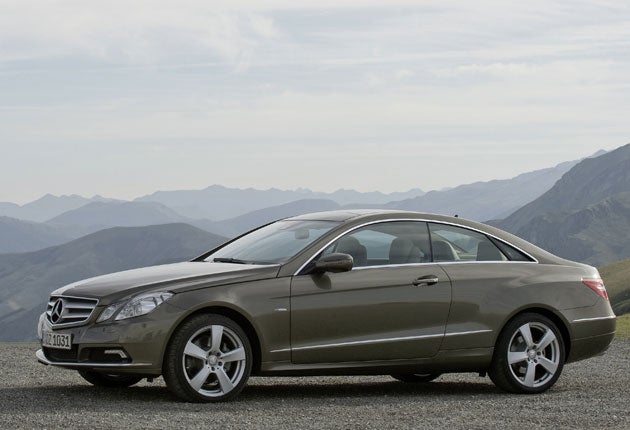Mercedes E-class coupé
The man behind the design of the Mercedes E-class coupé is proud of his clever creation, and he has every reason to be

Conversation was flowing well. Mercedes design director Karl-Heinz Bauer – you could identify him by the frock coat and the grey ponytail – was talking about the way Mercedes-Benzes have had to change.
I asked him what had happened to the notion of a Mercedes as a car above fashion, a car with an air of permanence able to transcend trends and still remain desirable even when replaced, occasionally, by a new model. He replied that people nowadays have more fashion awareness and shorter attention spans.
"Is that why your cars have become a little, well, overstyled and overwrought?" I ventured, bravely, to the architect of today's Mercedes look. "That's what people want," he replied. "They want something showy that marks their cars out as new, and we have new models more often than ever before."
This week's road test subject, and the reason for the conversation, is the perfect example. It's the new Mercedes-Benz E-class coupé, a car which supplants two generations of the smaller, C-class-based CLK. But the first CLK replaced an earlier E-class coupé, so we're back to a modern version of where we started.
The saloon version of the latest E-class was launched just a couple of months ago, and the coupé shares the saloon's mechanical make-up and its onslaught of electronic safety and convenience cleverness. It also shares many of its styling features, such as the paired-parallelogram headlights, the curve of the waistline, the slanting rear lights and, most controversially, the flared-out flourish over the rear wheel arch meant to evoke Mercedes-Benzes of the 1950s and early 1960s before straight-lined austerity took over.
Viewed in the context of a 1959 "fin-tail" Benz, then, the new E-classes are just reinterpreting those styling details for a modern age. If so, maybe the new Benzes will have lasting aesthetic qualities after all. Who's to know, apart from all of us in 10 years' time?
As a medium-size Mercedes coupé, this E-class must also have frameless side windows and no centre pillar. With the windows retracted there's a single open aperture between waistline and roof, which gives a great feeling of blowy freedom, especially if there's an optional sunroof you can open. But one small detail spoils the impression, a detail brought about by the way the rear side window's curve comes to a point aft. In order for the window to retract fully, its tip has to be separate and fixed. So there's an unsightly bar to act as a channel, and some of the effect is lost. How we suffer for the coupé art.
Inside, the latest E-classes return to the aura of quality and solidity that makes a Benz special, even though the new coupés, starting at £29,000, are about 5 per cent cheaper than the equivalently engined CLKs they replace. There's plenty of space in the back for a car of such sleekness (it's one of the most streamlined cars you can buy, with a coefficient of aerodynamic drag of just 0.24), and some of the new technology, some of it optional, is admirable.
Examples are Pre-Safe, which tightens seat belts if sensors detect an imminent accident, and clever headlights which alter their beam shape and distance according to speed, steering inputs and the presence of other traffic. A device which reads speed limit signs and displays them on the speedometer, in case you missed them, is more Big Brother-ish; it doesn't work with UK signs yet. And I'm not sure I want my car to tell me when I need a restorative coffee, which Attention Assist does.
An older piece of technology is the "belt butler", long a Mercedes coupé feature, which hands your seatbelt over your shoulder on an extending arm. It sets the tone for a thoroughly pleasing drive, based around crisp, accurate steering and a surprising feeling of agility. It's perhaps surprising that the coupé I enjoyed driving the most was the E250 CDI, with a new BlueEfficiency diesel engine scoring an amazing 204bhp from its 2.1 litres, relatively small wheels and normal, as opposed to sportified, suspension. It felt supple, poised, light footed and lovely, and its engine pulled as lustily as you could reasonably want.
It makes the V6-engined E350 CDI seem extravagant, although this diesel is very smooth, and the petrol-fuelled, V8-engined E500 seemed overkill given that it didn't feel as if it had 388bhp, and was heavier in the corners. Full marks, though, for the E250 CGI (G is for "gasoline"), which has a direct-injection, turbocharged petrol engine of just 1.8 litres yet producing 204bhp. That's the sort of intelligent downsizing I really like. Either way, if you can wait until September for a new E-class coupé with a 250 in its name, you'll have yourself a truly delightful car.
The Rivals
Audi A5 coupé 2.0 TDI:
from £28,115. Suave, elegant, less flamboyant than Mercedes. Less fast and less frugal, too, but still a likeable car. Quattro four-wheel drive is optional.
BMW 320d coupé:
from £28,530. Until now the keen driver's choice with rear-wheel drive and a punchy engine, but Mercedes has caught up. EfficientDynamics system includes a stop-start function.
Renault Laguna coupé 2.0 180 dCi GT:
£24,960. Renault misses the mark, despite a lusty engine and four-wheel steering. This car feels anaesthetised to drive yet fidgets over bumps.
Subscribe to Independent Premium to bookmark this article
Want to bookmark your favourite articles and stories to read or reference later? Start your Independent Premium subscription today.

Join our commenting forum
Join thought-provoking conversations, follow other Independent readers and see their replies